This article needs additional citations for verification .(December 2009) |
The Donald Duck pocket books are a series of paperback-sized publications published in various European countries, featuring Disney comics.
This article needs additional citations for verification .(December 2009) |
The Donald Duck pocket books are a series of paperback-sized publications published in various European countries, featuring Disney comics.
The pocket books were originally published irregularly (about 6 times a year) until 1987 and monthly since. They are roughly A5-sized (digest size) and about 250 pages thick. Each book has about eight stories, but the numbers of stories can vary widely from issue to issue. As of 10 September 2019, there are 524 issues. Almost all stories come from European publishers - namely Mondadori/Disney Italy from Italy and, more recently, Egmont from Denmark.
Most of the artists are from Italy (among the most famous and internationally renowned being Romano Scarpa, Marco Rota, Pier Lorenzo De Vita, Massimo De Vita, Giorgio Cavazzano, Giovan Battista Carpi, Luciano Bottaro) with a minority of Danish artists (such as Flemming Andersen), and very few stories are drawn by Spanish and Argentinian artists.
Just like their larger, comic book-sized European Disney comic counterparts and as is common with North-American superhero comics, hardly any story published in the pocket books is made by one single person, instead each story is a combined effort. An author writes a story for which the production company assigns an artist whose unique style they think most resembles the story's particular spirit, then the artist's drawings are completed, again as by management directions, first by a particular inker and then a particular colorist. These groupings can at times be only loose and variable from story to story (especially stable author-artist groupings are rare), but particular artist-inker-colorist groupings can last long enough to define what later is recognized as an artist's defined "style period". It was not until the late 1990s that the production companies began to print at least author and artist of each Disney story in their publications.
Until issue #118 [German numbering], a particular limitation of the pocket books out of economical reasons was that only half of the pages were printed in colour, while for the other half simply the uncoloured line art was printed. This was done in an alternating routine so that one pair of pages (left and right page) one was looking at was black and white, and turning to the next pair of pages they were in colour, etc. It was not until issue #119 (spring 1987, shortly before the move to monthly issues) that the pocket books were printed in full colour. In later reprints, these early issues were published in all-colour.
In the late 2000s, "mini" pocket books have also appeared. These mini pocket books are smaller (A6-sized rather than A5-sized) but have slightly more pages, and consist almost exclusively of reprints of stories in previously appeared full-size pocket books, rather than all-new material.
Since the 1990s, many additional side series have been launched, some of which were printed in many countries, others being more specific to a few areas. These include Christmas-, Easter-, summer-, winter and Halloween-themed books, big issues that collect a mixture of reprints and unissued stories, oversized "Premium" books dedicated to specific series (PKNA, X-Mickey, Mickey Mouse Mystery Magazine, Darkwing Duck, DoubleDuck and others), and editions dedicated to various characters. Some of these are one-shots, others appear with different regularity.
The blueprint for all the European pocket books was the Italian series I Classici, which reprinted and collected comics from the weekly and much thinner Topolino .
A special feature of these early issues of pocket books were the so-called framework stories. In these early days, the stories used to be connected with each other by a framework story, forming a general story line throughout the entire book. For every of those early issues, the publishers mostly chose unrelated stories from a large pool, and it was only after those stories had been chosen that a fitting framework would be written, then drawn in a sub-standard quality style by artist Giuseppe Perego. As the feature gradually fell out of use, Perego was partly replaced by Giancarlo Gatti, an artist whose quality is more on par with that of the usual production level and who like Perego often publishes full-length main stories instead of only doing "filler" frameworks in between these.
The framework feature was gradually dropped during the 1980s (roughly between the issues #80-#100), as nowadays each story is usually completely independent from the other stories in the same issue. In this era, the German/Scandinavian series became independent from the Italian role model. While I Classici continues to be released to this day, there is no connection between its story selection and the Egmont-selected pocketbooks anymore.
Since the same issue as full-color was introduced, the pocket books also feature pictures of Disney characters on their spines, a feature especially appealing to collectors as these pictures make it instantly apparent if an issue is missing when the pocket books are lined up on a cupboard. The first spine-assembly picture ran from 1987 until late 1991/early 1992, since then each spine picture (usually) spans a year (= 12 issues). This feature was also added to reprints of the early issues that originally did not have it.
Some of the stories have a "choose your own adventure" aspect (semi-officially called "Which-way stories"). The reading order of the story is not completely linear. At the end of approximately every fourth page a choice is presented to the reader about what the character should do next, with two or three options. The reader makes their choice by turning to the page mentioned in the option. Thus, stories of this kind have about six to eight alternative endings. A rarer variation of this is the stories that are built up like levels in a video game; there is only one ending but various ways to get there, which includes several "wrong" turns of events that lead back to a previous point in the story so that the reader has to choose a different path in order to eventually arrive at the end.
The same stories, which are mostly written and drawn by Italian writers and artists, are translated into different languages and appear in each country roughly about the same time, but there are differences of one or two months between the publishing schedules of different countries. As there was no connection between issues other than the recurring cast of characters, the early issues (until about #30?) were mostly published in different order all over Europe, so the German #3 for instance is not the same as the Danish, French, or Finnish #3. A few of the I Classici (e.g. the 1964 Olympics issue entirely by Romano Scarpa) also were never adapted outside Italy, and the stories weren't printed in the respective languages until much later.
Various local names for the Donald Duck pocket books include:
All these books started publishing in 1967 and 1968 respectively, except for the Finnish version, which started in 1970, the Polish which started in 1992, Icelandic which started in 1994 and Estonian which started in 2008. The Italian edition, published since 1957, [1] was the inspiration for the later European editions.

Keno Don Hugo Rosa, known simply as Don Rosa, is an American comic book writer and illustrator known for his Disney comics stories about Scrooge McDuck, Donald Duck, and other characters which Carl Barks created for Disney-licensed comic books, first published in America by Dell Comics. Many of his stories are built on characters and locations created by Barks; among these was his first Duck story, "The Son of the Sun" (1987), which was nominated for a Harvey Award in the "Best Story of the Year" category.
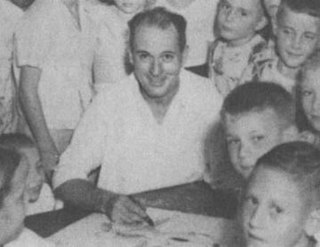
Charles Alfred "Al" Taliaferro, was an American Disney comics artist who produced Disney comic strips for King Features Syndicate. Taliaferro is best known for his work on the Donald Duck comic strip. Many of his strips were written by Bob Karp.
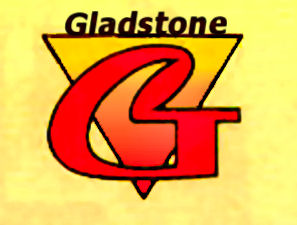
Gladstone Publishing was an American company that published Disney comics from 1986 to 1990 and from 1993 to 1998. The company had its origins as a subsidiary of Another Rainbow Publishing, a company formed by Bruce Hamilton and Russ Cochran to publish the Carl Barks Library and produce limited edition lithographs of Carl Barks oil paintings of the Disney ducks. The name references Gladstone Gander.
Disney comics are comic books and comic strips featuring characters created by the Walt Disney Company, including Mickey Mouse, Donald Duck and Uncle Scrooge.

Gemstone Publishing is an American company that publishes comic book price guides. The company was formed by Diamond Comic Distributors President and Chief Executive Officer Steve Geppi in 1994 when he bought Overstreet.
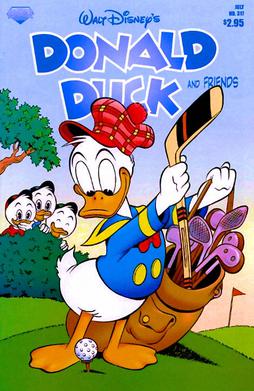
Donald Duck, also known as Donald Duck and Friends, is an American Disney comic book series starring the character Donald Duck and published by various publishers from October 1942 to June 2017. As with many early Disney comics titles, Donald Duck began as individual issues of Dell Comics' Four Color one-shots series. It was published as its own regular series in November 1952, starting with issue #26.

Mickey Mouse Adventures was a Disney comic book first published by Disney Comics from 1990 to 1991. It featured Mickey Mouse as the main character along with other characters from the Mickey Mouse universe. Somewhat similar in style to the animated series DuckTales, it was based on the continuity of earlier print material starring Mickey, mainly Floyd Gottfredson's stories in the Mickey Mouse comic strip.
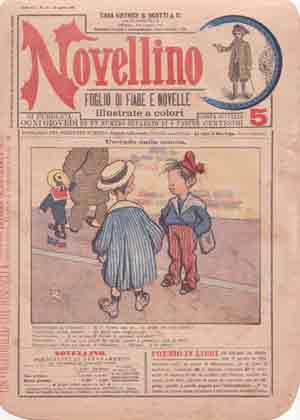
Italian comics, also known as fumetto[fuˈmetto], plural form fumetti[fuˈmetti], are comics that originate in Italy. The most popular Italian comics have been translated into many languages. The term fumetto refers to the distinctive word balloons that contain the dialogue in comics.
Donald Duck, a cartoon character created by the Walt Disney Company, is today the star of dozens of comic-book and comic-strip stories published each month around the world. In many European countries, Donald is considered the lead character in Disney comics, more important and beloved than Mickey Mouse.

Kalle Anka & C:o is a Swedish weekly Disney comics magazine, published by Egmont. The 52-page comic, launched in September 1948, is the overall best-selling Swedish comic magazine. In the early years, the comic printed translated stories from the United States, including Walt Disney's Comics and Stories, Four Color and other Dell Comics Disney titles. As Disney comics production waned in the United States in the 1960s, Kalle Anka began printing more European-produced content, from Scandinavia and Italy. Now, Kalle Anka & C:o and its Scandinavian sister editions Anders And & Co. (Denmark) and Donald Duck & Co (Norway) are identical, apart from the language.
Topolino is an Italian digest-sized comic series featuring Disney comics. The series has had a long running history, first appearing in 1932 as a comics magazine. It is currently published by Panini Comics.

Mickey Mouse is a Disney comic book series that has a long-running history, first appearing in 1943 as part of the Four Color one-shot series. It received its own numbering system with issue #28, and after many iterations with various publishers, ended with #330 from IDW Publishing.
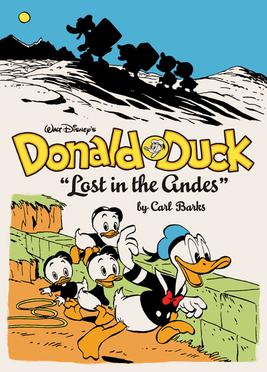
The Complete Carl Barks Disney Library is a series of books collecting all of the comic book Donald Duck and Uncle Scrooge stories written and drawn by Carl Barks, originally published between 1942 and Barks' retirement in June 1966. The series was launched in late 2011, and will comprise 6,000 plus pages over roughly 30 200- to 240-page volumes when it is finished.

Uncle Scrooge and Donald Duck: The Don Rosa Library is a series of books published by Fantagraphics Books, collecting all of the Scrooge McDuck and Donald Duck comic book stories written and drawn by Don Rosa, originally published between 1987 and 2006. Following up Fantagraphics' Floyd Gottfredson Library and The Complete Carl Barks Disney Library, this series was launched in 2014, and completed with the tenth and last volume in late 2018.
Donald Duck: The Complete Daily Newspaper Comics is a series of hardcover books collecting the complete run of the Disney Donald Duck comic strip, a daily newspaper comic strip drawn by the American comic artist Al Taliaferro. The comic strip debuted on February 7, 1938, and within eight weeks became the fastest growing syndicated comic strip worldwide. The publisher behind the project is IDW Publishing and their imprint, The Library of American Comics. The first book of the series was released on September 2, 2015.
Disney Masters is a series of books collecting anthologies of critically acclaimed Walt Disney Donald Duck and Mickey Mouse international comic artists. Italian artist Romano Scarpa was the first featured creator in the series, in the volume titled The Delta Dimension. The publisher behind the project is Fantagraphics Books. The first book of the series was released in May 2018.
Donald Duck is an American comic strip by the Walt Disney Company starring Donald Duck, distributed by King Features Syndicate. The first daily Donald Duck strip debuted in American newspapers on February 7, 1938. On December 10, 1939, the strip expanded to a Sunday page as well. Writer Bob Karp and artist Al Taliaferro worked together on the strip for more than 30 years. The strip ended in May 1995.

Mickey Mouse Magazine is an American Disney comics publication that preceded the popular 1940 anthology comic book Walt Disney's Comics and Stories. There were three versions of the title – two promotional giveaway magazines published from 1933 to 1935, and a newsstand magazine published from 1935 to 1940. The publication gradually evolved from a 16-page booklet of illustrated text stories and single-page comic panels into a 64-page comic book featuring reprints of the Mickey Mouse and Donald Duck comic strips.
Paperino e altre avventure, also known as Paperino giornale, is a 1937–40 weekly Italian Disney comics magazine published by Mondadori. The comic was launched by Federico Pedrocchi, Mondadori's art director, as a companion to the existing weekly Topolino magazine. Paperino published 149 issues from 30 December 1937 to 26 October 1940, at which point it was merged with Topolino.
Roope-setä was a Finnish comic book published by Sanoma Media Finland from 1978 to 2017, containing comics from the Donald Duck universe. The main protagonist in the comic was Scrooge McDuck.